

Kinsey-Henneman. The average American has 634 ties in their overall network, and technology users have bigger networks. The average American has 634 ties in their overall network, and technology users have bigger networks.

Social networking sites (SNS) provide people with the opportunity to friend members of their overall network of family members, coworkers, and other acquaintances. Much has been made of the use of the word “friend” in this context. Those who are listed as friends on SNS may indeed be friends in the traditional sense, but they can also be old acquaintances (e.g., from high school) or very casual connections between people who have never have met in person. Some worry that as a result of using these services, people may become more isolated and substitute less meaningful relations for real social support.
Others believe this might enrich and expand relationships. Looking at people’s overall social networks, not just their online ties, the average American has 634 ties in their overall network, and technology users have bigger networks. Facebook users have more close connections. Four ways social networking has forever changed the way we work. Every couple of years or so, a new technology revolution springs up, promising to replace stale, overhyped prior revolution that had just passed.This time, we're told, things will be different.
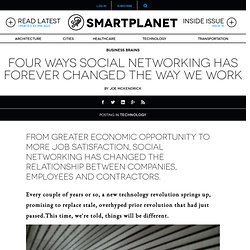
But this time, things really have been different. Social networking is more than a platform or a new mode of computing it represents a new way of connecting, of doing business, of leading nations, of working, of making friends and renewing friendships. Consider where the social revolution has taken us in just a few short years: In an increasingly complex world. Future - Science & Environment - Does the internet rewire your brain? Being online does change your brain, but so does making a cup of tea.
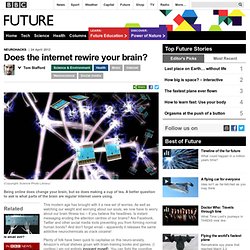
A better question to ask is what parts of the brain are regular internet users using. This modern age has brought with it a new set of worries. As well as watching our weight and worrying about our souls, we now have to worry about our brain fitness too – if you believe the headlines. Is instant messaging eroding the attention centres of our brains? Are Facebook, Twitter and other social media tools preventing you from forming normal human bonds? The power of mobility and the strength of collaboration at work. Innovation also passes through work spaces Technology is constantly changing and one of the main consequences of this change is mobility.
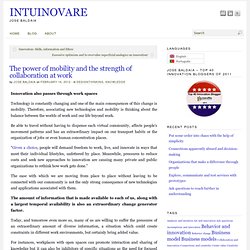
Therefore, associating new technologies and mobility is thinking about the balance between the worlds of work and our life beyond work. Be able to travel without having to dispense each virtual community, affects people’s movement patterns and has an extraordinary impact on our transport habits or the organization of jobs or even human concentration places. “Given a choice, people will demand freedom to work, live, and innovate in ways that meet their individual lifestyles, unfettered by place. Meanwhile, pressures to reduce costs and seek new approaches to innovation are causing many private and public organizations to rethink how work gets done.” The ease with which we are moving from place to place without leaving to be connected with our community is not the only strong consequence of new technologies and applications associated with them.
Individual.utoronto.ca/markfederman/WhyJohnnyandJaneyCantRead.pdf. Breaking Down Menus Digitally, Dish by Dish - The Digital Campus. By Jennifer Howard New York If you'd dined at the Sherman Square Hotel in New York City on May 31, 1937, you could have refreshed yourself with a sauerkraut-juice cocktail, moved on to cold soup in jelly, tucked into minced capon en crème or lamb's tongue with a side of potato salad, and finished off the meal with California figs in syrup or a nice slice of apple pie.
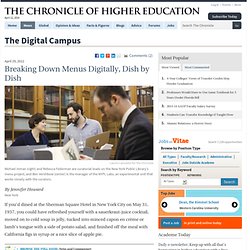
BROWSE THE FULL ISSUE: News and Commentary BUY A COPY: Digital and Print Editions at the Chronicle Store. MLA Urges Evaluators to 'Give Full Regard' to Digital Work - Wired Campus. The Modern Language Association wants evaluators to get with the digital program.

Loose Hierarchies, Strong Networks. When I wrote that the only knowledge that can be managed is our own, I wanted to highlight that command & control methods do not work well in this network era that is replacing the industrial/information era. Three Principles for Net Work. The nature of work is changing in our increasingly networked economy.

What was considered good, dependable work in the 20th century is now getting automated or outsourced. Automated tellers have replaced thousands of bank clerks but even more advanced jobs are getting automated as we connect the world with computers. The New York Times reported in March of 2011 that armies of expensive lawyers, who once did “discovery” work have been replaced by software programs that do the work at a fraction of the cost. The same applies to computer chip designers, loan officers and tax accountants. What is the (Next) Message?
2011 eXtension Virtual Conference. Disruptive innovation. Sustaining innovations are typically innovations in technology, whereas disruptive innovations cause changes to markets.
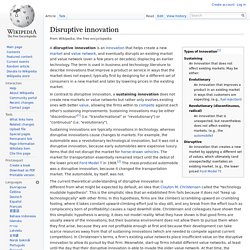
For example, the automobile was a revolutionary technological innovation, but it was not a disruptive innovation, because early automobiles were expensive luxury items that did not disrupt the market for horse-drawn vehicles. The market for transportation essentially remained intact until the debut of the lower priced Ford Model T in 1908. The mass-produced automobile was a disruptive innovation, because it changed the transportation market.